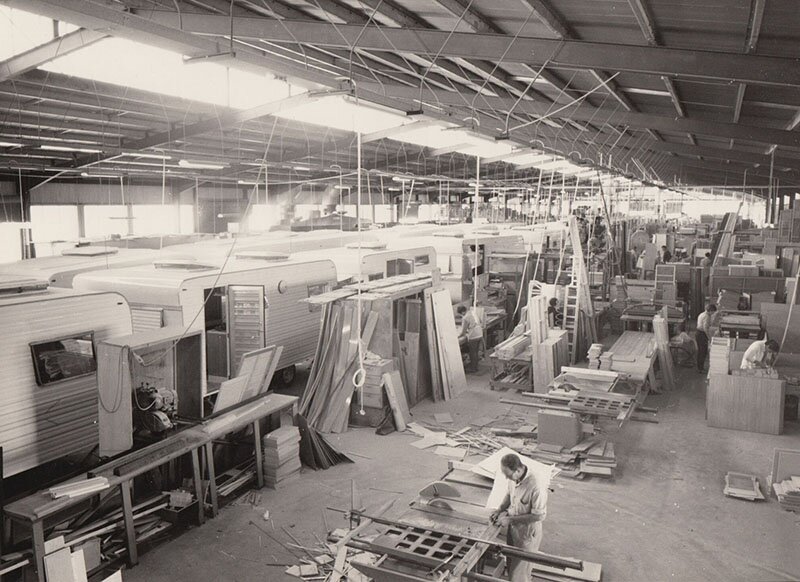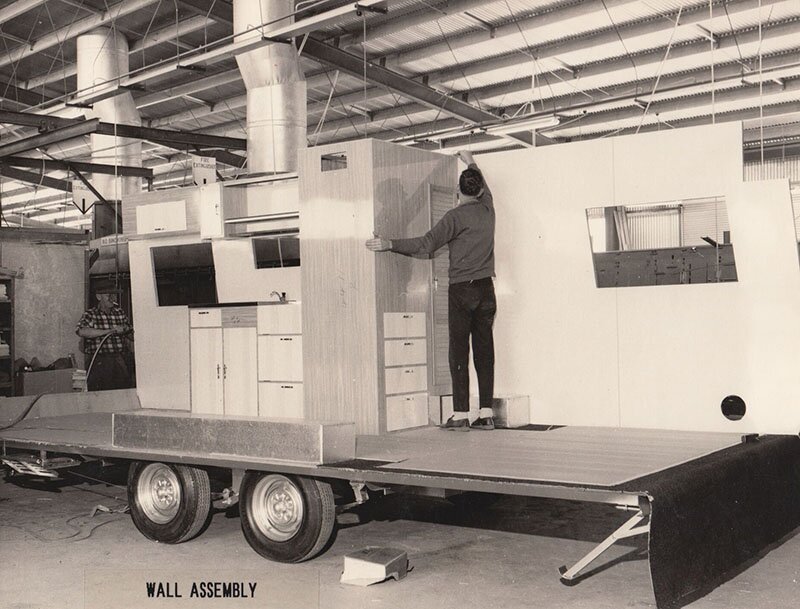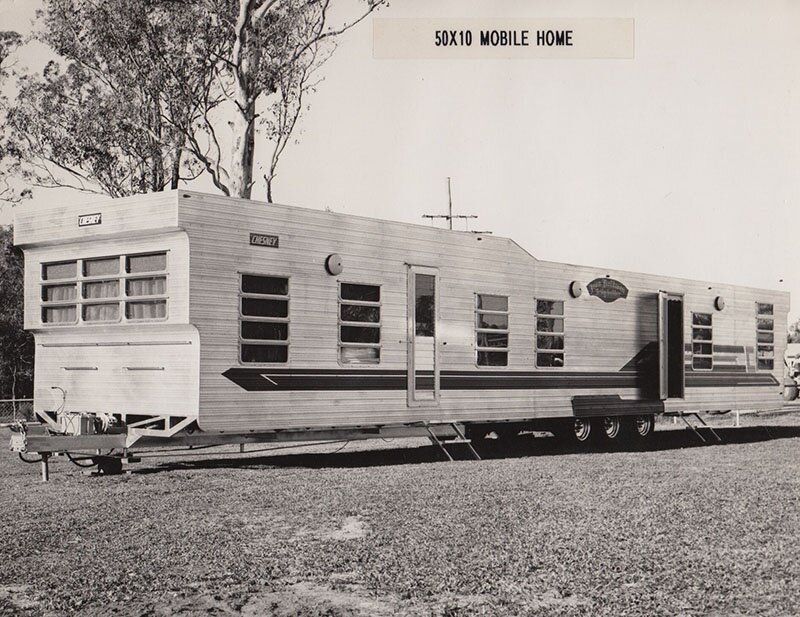He built a caravan empire and remains one of the industry’s greatest leaders and innovators. Even at age 79, he’s still working to make caravans better. By ROD BRUEM Stepping into Neil Chesney’s home office on the north side of Brisbane is like stepping into the trophy room of a celebrated sportsman. There are plaques alongside framed photographs of Neil being presented with awards. There’s the occasional memento from Australia’s golden days of caravanning in the 1960s and early 1970s when Chesney reigned supreme on the roads of Queensland and beyond. In a country like ours where we celebrate sports stars and show a grudging respect for successful business people, an office like this is rare. As you’d expect, so is the man who owns it. Neil Chesney will turn 80 next year and while he may be slowing down a little, there’s absolutely no mistaking the charisma that helped build one of the country’s most successful caravan manufacturers.  Along with Franklin Caravans in Victoria and Viscount Industries in NSW, Queensland-based Chesney mastered the mass production of caravans in the 1960s. It made holidays on wheels possible for thousands of Australian families and created many lifetimes of memories in the process. In the beginning Neil Chesney was born into a caravan family and for as long as he can remember he always wanted to build them. His father Alex was a successful caravan salesman, establishing what grew to become “Chesney Corner” at the busy intersection of Gympie and Rode Roads in Brisbane’s Chermside. Alex Chesney initially sold kit caravans that were popular in the early 1950s and was also the Queensland manager for Carapark caravans. Neil left school at age 14 to do an engineering apprenticeship and five years later he began making parts for his father to sell.
Along with Franklin Caravans in Victoria and Viscount Industries in NSW, Queensland-based Chesney mastered the mass production of caravans in the 1960s. It made holidays on wheels possible for thousands of Australian families and created many lifetimes of memories in the process. In the beginning Neil Chesney was born into a caravan family and for as long as he can remember he always wanted to build them. His father Alex was a successful caravan salesman, establishing what grew to become “Chesney Corner” at the busy intersection of Gympie and Rode Roads in Brisbane’s Chermside. Alex Chesney initially sold kit caravans that were popular in the early 1950s and was also the Queensland manager for Carapark caravans. Neil left school at age 14 to do an engineering apprenticeship and five years later he began making parts for his father to sell. “I used to build walls and chassis as kits for home handymen to put together themselves. There weren’t many manufacturers as such in those days. They would start out with two walls and a chassis and build it from there.” His first factory space was underneath the family’s Queenslander home, however demand increased quickly to the point where he had to find bigger premises and moved into an old boat shed at Breakfast Creek in Brisbane. It was there Neil Chesney built the first complete Chesney caravan, which proved to be a little too ahead of its time. “The first complete caravan I built was called a ‘Styleline”, unfortunately I don’t have photos although I built about six of them. What made the Styleline unique was it has it had acrylic in the hatches, just like vans do today. Back then buyers didn’t like that idea, they didn’t want to be able to see the sky, so I had to change it.” That minor setback aside, Chesney caravans quickly found favour with buyers as more Queenslanders bought cars and looked forward to holidays in the Sunshine State.
“I used to build walls and chassis as kits for home handymen to put together themselves. There weren’t many manufacturers as such in those days. They would start out with two walls and a chassis and build it from there.” His first factory space was underneath the family’s Queenslander home, however demand increased quickly to the point where he had to find bigger premises and moved into an old boat shed at Breakfast Creek in Brisbane. It was there Neil Chesney built the first complete Chesney caravan, which proved to be a little too ahead of its time. “The first complete caravan I built was called a ‘Styleline”, unfortunately I don’t have photos although I built about six of them. What made the Styleline unique was it has it had acrylic in the hatches, just like vans do today. Back then buyers didn’t like that idea, they didn’t want to be able to see the sky, so I had to change it.” That minor setback aside, Chesney caravans quickly found favour with buyers as more Queenslanders bought cars and looked forward to holidays in the Sunshine State. “Queensland was the destination state for caravans. People from down south holidayed here as they still do today, so there was quite a strong retail market here. A lot of southerners would buy a caravan here, or bring their caravan and trade up to a Chesney.” In 1960 production moved to a new factory at Stafford as Chesney moved away from timber construction and started building stylish lightweight aluminum caravans. “It took us five weeks to make our first van there, but it was an instant hit and at our peak we were building two caravans a day and we had to extend the factory three times.”
“Queensland was the destination state for caravans. People from down south holidayed here as they still do today, so there was quite a strong retail market here. A lot of southerners would buy a caravan here, or bring their caravan and trade up to a Chesney.” In 1960 production moved to a new factory at Stafford as Chesney moved away from timber construction and started building stylish lightweight aluminum caravans. “It took us five weeks to make our first van there, but it was an instant hit and at our peak we were building two caravans a day and we had to extend the factory three times.” In 1965 Chesney received the biggest order of his career when he was commissioned to build 500 caravans to be used as temporary housing for workers at the new aluminum smelter at Gladstone. He later bought the vans back for a fraction of the sale price, refurbished them and held one of Queensland’s biggest caravan sales of all time. “So many people turned up wanting to buy a van, we actually had to limit the number who could enter the site and they queued to buy them,” he said. In 1968 came another move, this time to a purpose-built factory complex on a 10 acre site at Lawton where caravans were produced at the rate of 22 per day. As well as caravans, the factory turned out a wide range of industrial vehicles, school buses, slide on campers, motorhomes and the “Kampa” range of lightweight pop top campers. Always the innovator, Neil Chesney was soon to introduce another great breakthrough, becoming the first Australian manufacturer to mass produce caravans using composite fibreglass materials.
In 1965 Chesney received the biggest order of his career when he was commissioned to build 500 caravans to be used as temporary housing for workers at the new aluminum smelter at Gladstone. He later bought the vans back for a fraction of the sale price, refurbished them and held one of Queensland’s biggest caravan sales of all time. “So many people turned up wanting to buy a van, we actually had to limit the number who could enter the site and they queued to buy them,” he said. In 1968 came another move, this time to a purpose-built factory complex on a 10 acre site at Lawton where caravans were produced at the rate of 22 per day. As well as caravans, the factory turned out a wide range of industrial vehicles, school buses, slide on campers, motorhomes and the “Kampa” range of lightweight pop top campers. Always the innovator, Neil Chesney was soon to introduce another great breakthrough, becoming the first Australian manufacturer to mass produce caravans using composite fibreglass materials. When the Regal was released in 1970 it was unlike any caravan before. It came with a sleek fiberglass front and rear as well as a one-piece fibreglass roof. Not only did it make the van much lighter, but it also virtually eliminated the risk of roof leaks. Sadly it was an innovation that was short lived... Link: Read the full story in Issue 16 of Time to Roam.
When the Regal was released in 1970 it was unlike any caravan before. It came with a sleek fiberglass front and rear as well as a one-piece fibreglass roof. Not only did it make the van much lighter, but it also virtually eliminated the risk of roof leaks. Sadly it was an innovation that was short lived... Link: Read the full story in Issue 16 of Time to Roam.
 Along with Franklin Caravans in Victoria and Viscount Industries in NSW, Queensland-based Chesney mastered the mass production of caravans in the 1960s. It made holidays on wheels possible for thousands of Australian families and created many lifetimes of memories in the process. In the beginning Neil Chesney was born into a caravan family and for as long as he can remember he always wanted to build them. His father Alex was a successful caravan salesman, establishing what grew to become “Chesney Corner” at the busy intersection of Gympie and Rode Roads in Brisbane’s Chermside. Alex Chesney initially sold kit caravans that were popular in the early 1950s and was also the Queensland manager for Carapark caravans. Neil left school at age 14 to do an engineering apprenticeship and five years later he began making parts for his father to sell.
Along with Franklin Caravans in Victoria and Viscount Industries in NSW, Queensland-based Chesney mastered the mass production of caravans in the 1960s. It made holidays on wheels possible for thousands of Australian families and created many lifetimes of memories in the process. In the beginning Neil Chesney was born into a caravan family and for as long as he can remember he always wanted to build them. His father Alex was a successful caravan salesman, establishing what grew to become “Chesney Corner” at the busy intersection of Gympie and Rode Roads in Brisbane’s Chermside. Alex Chesney initially sold kit caravans that were popular in the early 1950s and was also the Queensland manager for Carapark caravans. Neil left school at age 14 to do an engineering apprenticeship and five years later he began making parts for his father to sell. “I used to build walls and chassis as kits for home handymen to put together themselves. There weren’t many manufacturers as such in those days. They would start out with two walls and a chassis and build it from there.” His first factory space was underneath the family’s Queenslander home, however demand increased quickly to the point where he had to find bigger premises and moved into an old boat shed at Breakfast Creek in Brisbane. It was there Neil Chesney built the first complete Chesney caravan, which proved to be a little too ahead of its time. “The first complete caravan I built was called a ‘Styleline”, unfortunately I don’t have photos although I built about six of them. What made the Styleline unique was it has it had acrylic in the hatches, just like vans do today. Back then buyers didn’t like that idea, they didn’t want to be able to see the sky, so I had to change it.” That minor setback aside, Chesney caravans quickly found favour with buyers as more Queenslanders bought cars and looked forward to holidays in the Sunshine State.
“I used to build walls and chassis as kits for home handymen to put together themselves. There weren’t many manufacturers as such in those days. They would start out with two walls and a chassis and build it from there.” His first factory space was underneath the family’s Queenslander home, however demand increased quickly to the point where he had to find bigger premises and moved into an old boat shed at Breakfast Creek in Brisbane. It was there Neil Chesney built the first complete Chesney caravan, which proved to be a little too ahead of its time. “The first complete caravan I built was called a ‘Styleline”, unfortunately I don’t have photos although I built about six of them. What made the Styleline unique was it has it had acrylic in the hatches, just like vans do today. Back then buyers didn’t like that idea, they didn’t want to be able to see the sky, so I had to change it.” That minor setback aside, Chesney caravans quickly found favour with buyers as more Queenslanders bought cars and looked forward to holidays in the Sunshine State. “Queensland was the destination state for caravans. People from down south holidayed here as they still do today, so there was quite a strong retail market here. A lot of southerners would buy a caravan here, or bring their caravan and trade up to a Chesney.” In 1960 production moved to a new factory at Stafford as Chesney moved away from timber construction and started building stylish lightweight aluminum caravans. “It took us five weeks to make our first van there, but it was an instant hit and at our peak we were building two caravans a day and we had to extend the factory three times.”
“Queensland was the destination state for caravans. People from down south holidayed here as they still do today, so there was quite a strong retail market here. A lot of southerners would buy a caravan here, or bring their caravan and trade up to a Chesney.” In 1960 production moved to a new factory at Stafford as Chesney moved away from timber construction and started building stylish lightweight aluminum caravans. “It took us five weeks to make our first van there, but it was an instant hit and at our peak we were building two caravans a day and we had to extend the factory three times.” In 1965 Chesney received the biggest order of his career when he was commissioned to build 500 caravans to be used as temporary housing for workers at the new aluminum smelter at Gladstone. He later bought the vans back for a fraction of the sale price, refurbished them and held one of Queensland’s biggest caravan sales of all time. “So many people turned up wanting to buy a van, we actually had to limit the number who could enter the site and they queued to buy them,” he said. In 1968 came another move, this time to a purpose-built factory complex on a 10 acre site at Lawton where caravans were produced at the rate of 22 per day. As well as caravans, the factory turned out a wide range of industrial vehicles, school buses, slide on campers, motorhomes and the “Kampa” range of lightweight pop top campers. Always the innovator, Neil Chesney was soon to introduce another great breakthrough, becoming the first Australian manufacturer to mass produce caravans using composite fibreglass materials.
In 1965 Chesney received the biggest order of his career when he was commissioned to build 500 caravans to be used as temporary housing for workers at the new aluminum smelter at Gladstone. He later bought the vans back for a fraction of the sale price, refurbished them and held one of Queensland’s biggest caravan sales of all time. “So many people turned up wanting to buy a van, we actually had to limit the number who could enter the site and they queued to buy them,” he said. In 1968 came another move, this time to a purpose-built factory complex on a 10 acre site at Lawton where caravans were produced at the rate of 22 per day. As well as caravans, the factory turned out a wide range of industrial vehicles, school buses, slide on campers, motorhomes and the “Kampa” range of lightweight pop top campers. Always the innovator, Neil Chesney was soon to introduce another great breakthrough, becoming the first Australian manufacturer to mass produce caravans using composite fibreglass materials. When the Regal was released in 1970 it was unlike any caravan before. It came with a sleek fiberglass front and rear as well as a one-piece fibreglass roof. Not only did it make the van much lighter, but it also virtually eliminated the risk of roof leaks. Sadly it was an innovation that was short lived... Link: Read the full story in Issue 16 of Time to Roam.
When the Regal was released in 1970 it was unlike any caravan before. It came with a sleek fiberglass front and rear as well as a one-piece fibreglass roof. Not only did it make the van much lighter, but it also virtually eliminated the risk of roof leaks. Sadly it was an innovation that was short lived... Link: Read the full story in Issue 16 of Time to Roam.






